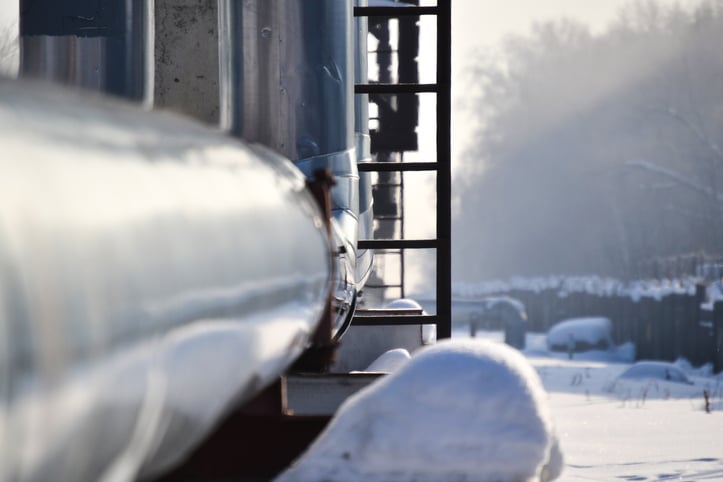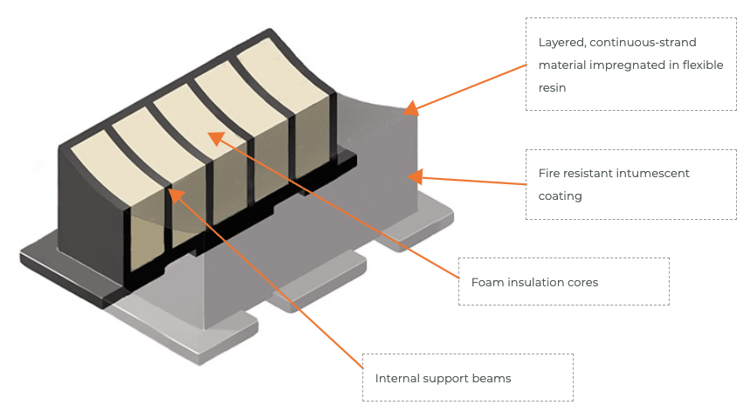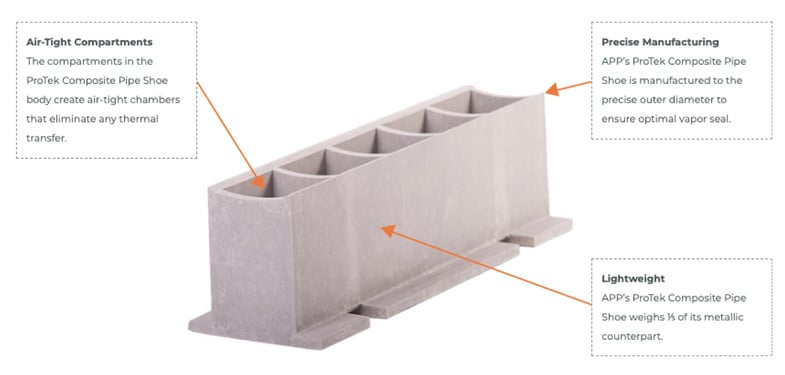
If you’ve worked with a heavy process piping system before, you already know—your pipes need protection. Left bare, metal pipes are exposed to scrapes, worn points, ruptures, and corrosion. Pipe shoes can add a layer of support that helps your whole system work more smoothly and for a longer period of time.
However, when it comes down to knowing which pipe shoes fit your system best, you’ll want to weigh your options.
We’re here to help. We’ve outlined CryoTek Pipe Shoes versus ProTek Composite Pipe Shoes and the role of these products in your piping systems. Read on for the ins and outs of these two piping protectors.
What Is a Pipe Shoe?
Pipe shoes elevate piping and insulate pipes from beams. They keep pipes from rubbing against dissimilar metals. But they also protect existing insulation from wearing down or being torn when pipes move. Another key role of pipe shoes is to control heat and reduce heat transfer. Pipe shoes lift piping off metal structures so there is less heat transfer, thermal expansion, and ice formation.
How Do They Work?
Pipe shoes work by lifting piping off support beams or structures. They usually cradle the pipe and fit directly underneath it. That means they need to be extremely durable and withstand thousands of pounds of pressure along with any elements the pipe may come in contact with.
CryoTek Pipe Shoe and ProTek Composite Pipe Shoe Similarities
CryoTek Pipe Shoes and ProTek Composite Pipe Shoes have the same general function. Both prevent the destruction that comes with metal-on-metal contact, both are designed to withstand extreme cold, and both are lightweight and easy to install.
They’re also both comprised of composite material rather than metal. There are several advantages to using composite pipe shoes over their metal counterparts. First, they prevent heat transfer. In general, you’ll want to keep the heat or cold that lives within the pipe inside, and you’ll want to keep external heat outside the piping. That’s because when there’s heat transfer, it causes thermal expansion, movement, ice formation, and worn-down pipes.
Additionally, composite pipe shoes don’t require welding, and they fit directly against the pipe without a need for added insulation. Bypassing welding helps you avoid creating weak spots in your system that would need extra attention down the line.
Overall, both CryoTek Pipe Shoes and ProTek Composite Pipe Shoes can help make piping systems last longer. However, they each have unique characteristics:
CryoTek Pipe Shoes
CryoTek Pipe Shoes are specifically designed for extreme temperature conditions. That means they’re well-suited for piping systems with gas liquefaction, ethylene plants, and cryogenic process systems. They work at temperatures as low as minus 320 degrees Fahrenheit, but they also can withstand temperatures as high as 400 degrees Fahrenheit.
Wondering how this is different from other pipe supports? In the past, many cold piping systems used pre-insulated pipe supports or stainless steel pipe shoes. Pre-insulated pipe shoes use a denser foam in order to bear the load of pipes. Denser foam means they will have much lower insulation properties.

CryoTek Pipe Shoes feature foam-insulated cores. That means they remain lightweight but don’t lose insulation properties. At the same time, they help regulate temperature and friction.
ProTek Composite Pipe Shoes
ProTek Composite Pipe Shoes can hold up in extreme temperatures too. In fact, they work in temperatures as low as minus 320 degrees Fahrenheit as well. Like CryoTek Pipe Shoes, they are especially resistant to chemicals and ultraviolet rays. That makes them ideal for plants and refineries as well as onshore or offshore rigs.
Simply put, ProTek Composite Pipe Shoes are made to withstand the elements. And their composite design protects them against naturally corrosive environments and substances.

They’re also built to improve the way your pipes function. ProTek Composite Pipe Shoes are made up of airtight chambers that stop energy transfer. They’re secured to the pipe with stainless steel bands, which means you don’t need to weld pieces to the pipe.
Skipping welding is an extra advantage in salt-heavy environments because welding spots are vulnerable to chloride stress corrosion cracking.
Have Questions About Pipe Shoes?
If you have questions about pipe shoes or what type of pipe support will work best with your process piping system, we can help. Go here to send us a note or ask for a quick quote.






